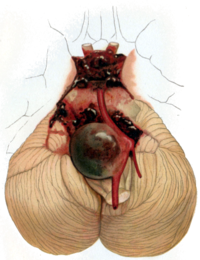
Photo from wikipedia
A 55‐year‐old man underwent successful percutaneous coronary intervention for the middle left circumflex artery with a 3.5 × 28‐mm bioresorbable vascular scaffold (BVS). At 18 months, follow‐up coronary angiography showed… Click to show full abstract
A 55‐year‐old man underwent successful percutaneous coronary intervention for the middle left circumflex artery with a 3.5 × 28‐mm bioresorbable vascular scaffold (BVS). At 18 months, follow‐up coronary angiography showed ectatic change with aneurysm formation over the BVS. Optical coherence tomography revealed absence of strut continuity at the aneurysm site, in the middle of the BVS. A literature review identified nine patients with intrascaffold aneurysm, including the present patient, which developed 6–32 months after BVS implantation. Of these nine patients, four underwent percutaneous coronary intervention for chronic total occlusion. The pathogenesis of coronary artery aneurysm is multifactorial. Most patients receive no further intervention, but long‐term dual antiplatelet therapy is sometimes prescribed in conjunction with regular follow‐up. © 2017 Wiley Periodicals, Inc.
Journal Title: Catheterization and Cardiovascular Interventions
Year Published: 2017
Link to full text (if available)
Share on Social Media: Sign Up to like & get
recommendations!